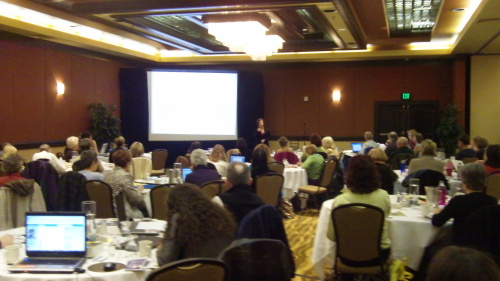Heather Lutze Speaking at AuthorU About SEO
Posted by Marty Dickinson on Feb 27, 2010
I’m sitting here on a Saturday morning on February 27, 2010, and just heard Heather Lutze for the first time speaking about SEO to a group of 90 or so at AuthorU’s first all-day Saturday seminar event, led by Judith Briles. Heather did a great job explaining the “sweet spot” so to speak for which we should be targeting keywords.

It always seems like people I talk to want the “big” keywords. But, she showed how the best keyword phrases to go after are in the 3, 4, 5, 6 keyword phrases. In fact, she reported that 52.9% of all people searching on search engines search for more than 3 keywords in their search phrase.
I also liked her examples of mistakes that most authors make with their websites, like having a page with the title “About the Author.” What exactly does “about the author” have to offer Google as a search term? Nothing. And, so many authors have a page expecting to get search presence for “about the author.”
Heather is a frequent speaker around the country and is located in Denver. Her SEO company, the Findability Group has 11 employees and has been around for 10 years. I recommend Heather for any speaking gig with an audience that would appreciate education on current SEO techniques.
Yahoo Adopts Real-Time Search
Posted by Marty Dickinson on Feb 23, 2010
It’s all over the news. Yahoo! has finalized a partnership with Twitter to incorporate Twitter’s tweets into Yahoo!’s search database. When someone adds a tweet about a topic and it immediately displays in a search on Yahoo! based on the keywords used in the tweet, that is called real-time search.
Some people believe real-time search will overpower regular search on main search engines, thereby forcing people to be active on Twitter and other social networks if they ever hope to generate traffic from search engines.
But, that doesn’t make sense for two main reasons:
1) It will be too easy for hackers to game the real-time search system so that only their massive quantities of tweets will drive the content generated for search engines to post.
2) Standard search content will always be a necessary component of search engines because tweets can still only be 140 characters in length. And, people expect that when they do a search, that a page will display with enough content for them to be informed.
So, yes, real-time content will be an important factor of search going forward, but that doesn’t mean stop making blog posts, adding pages to your site and optimizing both of those for search engines. Search engines including Yahoo! will still need your content beyond 140 characters.
Beware of Google SEO Scams
Posted by Marty Dickinson on Feb 22, 2010
I just read this post on one of my favorite forums…
Poster’s Comment:
“I have a problem with an SEO service I ordered and I’m not sure what to do. Last month, I hired a guy from XXXXXXXX for SEO on a site I have. He guaranteed he could bring my site to Google 1st page in 60 days, even for a fairly competitive keyword.
I know, it seemed too good to be true, but the guy had 36 reviews at XXXXXXXX and most were 10 out of 10. He seemed like a top notch pro.
So I hired him, but I made the mistake of paying him through his website and not through XXXXXXXX-per his direction. I trusted him, cause nothing indicated that he was scamming me.
This month, I asked him for an update, and his response was that this was not a standard link building campaign, and that his group knows how to manipulate Google’s algorithms and that they are updated every 60 days, so I would just need to wait till March 10 or thereabouts and my site would be 1st page.
This really made me nervous, cause I thought this was a conventional SEO campaign. Now, I don’t know what to do. This guy claims that his group has the ability to put sites in Google top 10 and/or get them banned. He’s very confident and seems to know what he’s talking about.
Now, I have only a few days before my ability to file a Paypal dispute expires, and I paid him $750, so it’s not chump change. However, I don’t want this guy messing up my site either. He doesn’t have any of my login info so he can’t do anything on page.”
- – - – -
End Poster’s Comment
There are several things wrong with what happened to this unfortunate chap. I’ve been performing SEO services and consulting (one of many services) to clients for somewhere around 13 years, so let’s take a look so that you don’t find yourself in a similar place.
1. Who He Hired – There are plenty of people in the SEO business. You should never have to hire someone that you were not referred to by someone else you know who has had that person do work directly for them.
2. What He Promised – There are no guarantees with Google. If someone guarantees you anything about SEO or SERP positions, run the other way as fast as you can.
3. How He Reinforced – Be careful of reviews and testimonials. Anyone who uses testimonials that are real will want to promote that person in thanks for offering a testimonial by at least giving a url for their website. Visit the websites and test for your own findings.
4. What He Charged – $750 to guarantee your ownership on organic search of a primary, competitive keyword, is just crazy. If I was to guarantee anyone a #1 position on Google for a single keyword or even a 2-word keyword phrase, I’d want $50,000 a month! And, it would probably take that amount of labor time to get you there.
5. What He Didn’t Know – The site owner just simply didn’t know that there’s nothing that takes Google 2 full MONTHS to do. Well, maybe if you’re on a severe Google black list, it might take you a while to get removed and then re-posted. But, when it comes to having your site display and for site links to start having an impact, no way, 2 months? Just no way will it take Google that long to show changes in positioning.
Just as I reported before that there seems to be some kind of wave of webmasters bringing pain to their clients, this proves true on the services end for SEO scams out there as well. Be extremely cautious and skeptical when someone approaches you with some kind of plan that they will “guarantee” your positions on Google. And, ask yourself why they’re willing to perform all that magic for you for so little. Beware of the Google SEO scams. They are apparently everywhere.
Question: Have you been scammed by a Google SEO’er? Tell us about it and what to watch out for.
Part 2 of 7 Numbers to Know to Grow Your Business: Sales
Posted by Marty Dickinson on Feb 16, 2010
How many sales do you need to make the amount of money you want to have in a year? As simple as this question might be, I’ve found very few people actually have this number in the top of their minds.
If you want to take home $500,000 over the next 12 months, you either need one big sale at the end of the year, or an average of $42,000 each month, right? Of course, that’s figuring you have no costs involved.
Once you do have costs to add to the equation, the calculation gets more complicated. And, costs can fluctuate from month to month. Now managing that almost sounds too much like work, doesn’t it?
Y’know, there are a few things that I consider myself to be at least semi-skilled at doing…but accounting is not one of them! So, I’m not even going to suggest how to come up with a formula for calculating required sales to generate $500,000 net profit, by subtracting fixed and variable costs.
No, I have an accounting system to do that for me.
What I will say is that it will take more than monitoring leads to get to your number of sales needed for your desired income level. Here is a short sequence to demonstrate what I’m talking about.
1. Determine your sales goal. Let’s say you want to make $100,000 in sales next month.
2. Calculate your current conversion rates. For this example, let’s just keep it easy and say the only way you get leads and sales is through your website.
Now let’s say that for every 1000 visitors, you “convert” 2.5 of those visitors to leads. That’s a .25% conversion rate. Let’s also say you are a master seller and convert every lead that comes to you into a sale. Good job! You’re a sales machine! Again, we’re just trying to make the calculation easier for the example.
3. Use this formula to figure out how many visitors you would need to your website to acquire enough leads to get the sales you want.
(Desired Sales / Sale Price / Conversion Rate) X 100
Now, let me explain that…
The / marks signify “division,” so you have to remember your old math here and do all your divisions first and then multiply X 100.
So, if I want $100,000 in sales and my sale price is, say a $20 ebook, and I only have a conversion rate of a measly .25%, my formula would look like this:
(100,000 / 20 / .25) X 100 = 2,000,000 Visitors Needed to achieve $100,000 in sales
Now, there are only a few things you can change about this fact. You can change your price. You can change your visitation or you can change your conversion rate. In your situation, what would be easiest to change?
For most people, it’s the conversion rate. If you test a bit, it’s actually quite easy to bring a .25% conversion rate into the 1.5% or even 2% range.
Let’s look at the difference using the formula:
(100,000 / 20 / 2) X 100 = 250,000 visitors.
That’s a huge difference my friend!
Now let’s say that simple ebook is raised in price to $47. Quite possibly your conversion rate will stay the same or even go up. It’s not unusual! So, let’s continue with the example and just say:
(100,000 / 47 / 2) X 100 = 106,383
You can hopefully see how important it is to start playing with numbers when planning for the coming months and year of your business. Of course this calculation can be expanded to include suspects, prospects, leads, and sales, but I just wanted to keep this example easy.
We’re only part way through the seven though, so stay tuned until next time where I’ll reveal the third number to watch in your business.
The key to knowing how many sales you will get is knowing how many leads you need.
Part 1 of 7 Numbers to Know to Grow Your Business: Leads
Posted by Marty Dickinson on Feb 5, 2010
How many leads did you get last month? I don’t mean visits to your website or even those that called you on the phone or submitted something to your contact us form. Those are just “suspects.” Then, if you’re lucky, some of them will turn into “prospects.” If you’re a good sales person, several of those prospects will finally turn into leads.
Now, here’s the kicker. Any idea how much money you spent to get those “leads?” How much has each lead cost you in marketing dollars to attract? If your cost is $20 per lead, can you imagine what the difference would be in your bottom line if you could reduce that number from $20 to $18 or even $15?
Over the next six of seven entries to this blog, I’m going to unveil 7 secret numbers that you need to be able to track every day, or at least every week, to assure your company is growing in a positive direction.
Once you form the habit of looking at all of these numbers combined, you will see how easy it is to use the numbers to PLAN for your future instead of always looking back on the results.
In this crazy economy, I honestly don’t know how anyone would be able to look the other way and NOT pay attention to these 7 numbers.
I’ve been in business for 15 years and in the sales arena for even more. And, I was only introduced to these 7 numbers a few weeks ago by a local guy here in Denver, Jeff Prager.
Jeff and his team run a web-based accounting system he developed.
And, contrary to other accounting systems I’ve used, the first goal above anything else with his accounting system is to keep a running total of these 7 numbers. So, literally, I can spend just 5 minutes every few days in my accounting system by running this one simple report and know all the 7 numbers I’m going to be covering in this series. Pretty cool. Anyway, let’s get back to the actual discussion about today’s topic…leads!
What is it exactly that you need to know that you can’t mentally store in your mind week after week? I mean, most of us can think, “Hmm, I think I got 10 new leads last month.
But, there’s a lot more to it than that…
There are three things you need to know about your leads, including:
1. What main sources did your leads come from? The Internet, a trade show, a magazine ad are examples of main source.
2. What “specific sources” did your leads come from? Organic search, PPC, Another website, response to a blog post on someone else’s blog, are all examples of specific lead source.
3. How would you rank the quality value of each of those leads from your source and specific source?
4. Where are they in the sales cycle? I like to rank my leads with the following:
.10 = suspect (not even really a lead yet)
.25 = prospect (someone who is actually interested and we’re talking more)
.50 = proposal is made (just waiting for questions to come in from proposal and next discussion)
.75 = proposal was accepted and the deal is probably going to happen)
.90 = proposal accepted (just waiting for the check or credit card payment, since I do everything pre-paid)
1.00 = client
0 = dead lead
99 = former client
5. How much traffic to your website do you need to get one lead?
6. How many leads to you need to get a sale
7. How much time or money do you need to spend to get those leads?
Number 6 and 7 there are sort of getting into the next part of the series, so I’ll stop there. Let’s just say that for this step, I’d like you to consider all 7 of those items as they relate to simply getting and managing leads.
Your traffic can be monitored, of course, through your Google Analytics account. The quality of the lead can be determined when you talk on the phone or receive an email. And, of course, the number of leads you need to get a sale is called a sales conversion rate. I’m going to go into more detail on those in part 2 and 3 of this series.
Sign-up for our rss feed to be notified every time a new post is added or add your email address to be sent an email every time a new post is added.
Checkout the accounting package I was telling you about earlier if you have another few moments.
Sure, it’s a product that I am promoting as one of my many affiliate products now and let it be publicly known that I will be financially compensated if you click the link and buy their product. But, I’ll tell ya, it took me evaluating this system for a MONTH before I finally was convinced to give it a shot. We’re only in our first month of using it and our sales planning time for 2010 has been cut from like, what, 30 hours or so of manual spreadsheet creating, to like minutes of clicking reports from the system.
Anyway, I don’t want to get too crazy on you about the product. Next time, I’ll cover Part 2, the second number you must be watching every day or at least every week to even HOPE to survive in business and grow.






